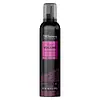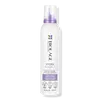What's inside
What's inside
 Benefits
Benefits

No benefits
 Concerns
Concerns

 Ingredients Side-by-side
Ingredients Side-by-side

Water
Skin ConditioningIsobutane
Hydrofluorocarbon 152a
Vp/Va Copolymer
Propane
Polyquaternium-11
Polysorbate 20
EmulsifyingPvp
Emulsion StabilisingPolyquaternium-4
Sodium Benzoate
MaskingParfum
MaskingOlealkonium Chloride
PPG-12-PEG-50 Lanolin
EmulsifyingPolyquaternium-7
Disodium EDTA
Cocamidopropyl Betaine
CleansingSorbitol
HumectantGlycerin
HumectantPropylene Glycol
HumectantAlpha-Isomethyl Ionone
PerfumingBenzyl Alcohol
PerfumingBenzyl Salicylate
PerfumingCoumarin
PerfumingGeraniol
PerfumingLimonene
PerfumingLinalool
PerfumingWater, Isobutane, Hydrofluorocarbon 152a, Vp/Va Copolymer, Propane, Polyquaternium-11, Polysorbate 20, Pvp, Polyquaternium-4, Sodium Benzoate, Parfum, Olealkonium Chloride, PPG-12-PEG-50 Lanolin, Polyquaternium-7, Disodium EDTA, Cocamidopropyl Betaine, Sorbitol, Glycerin, Propylene Glycol, Alpha-Isomethyl Ionone, Benzyl Alcohol, Benzyl Salicylate, Coumarin, Geraniol, Limonene, Linalool
Water
Skin ConditioningIsobutane
Propane
Polyquaternium-11
Polyquaternium-4
PEG-40 Hydrogenated Castor Oil
EmulsifyingPEG-6 Cocamide
EmulsifyingPhenoxyethanol
PreservativeParfum
MaskingTetrasodium EDTA
PEG-11 Methyl Ether Dimethicone
EmulsifyingLimonene
PerfumingEthylhexyl Methoxycinnamate
UV AbsorberHexyl Cinnamal
PerfumingCoumarin
PerfumingLinalool
PerfumingBenzyl Alcohol
PerfumingPPG-5-Buteth-5
Skin ConditioningAmyl Cinnamal
PerfumingHydroxycitronellal
PerfumingAlpha-Isomethyl Ionone
PerfumingGeraniol
PerfumingIsoeugenol
PerfumingBenzyl Benzoate
AntimicrobialCinnamyl Alcohol
PerfumingCitronellol
PerfumingAgave Tequilana Leaf Extract
AstringentCitric Acid
BufferingWater, Isobutane, Propane, Polyquaternium-11, Polyquaternium-4, PEG-40 Hydrogenated Castor Oil, PEG-6 Cocamide, Phenoxyethanol, Parfum, Tetrasodium EDTA, PEG-11 Methyl Ether Dimethicone, Limonene, Ethylhexyl Methoxycinnamate, Hexyl Cinnamal, Coumarin, Linalool, Benzyl Alcohol, PPG-5-Buteth-5, Amyl Cinnamal, Hydroxycitronellal, Alpha-Isomethyl Ionone, Geraniol, Isoeugenol, Benzyl Benzoate, Cinnamyl Alcohol, Citronellol, Agave Tequilana Leaf Extract, Citric Acid
Ingredients Explained
These ingredients are found in both products.
Ingredients higher up in an ingredient list are typically present in a larger amount.
Alpha-Isomethyl Ionone is a fragrance. It can be synthetically created or naturally occurring.
The scent of Alpha-Isomethyl Ionone is described as "flowery" but can also be "woody".
Naturally occurring Alpha-Isomethyl Ionone may be found in Saccharomyces cerevisiae, or the yeast used to make wine and bread.
The term 'fragrance' is not regulated in many countries. In many cases, it is up to the brand to define this term. For instance, many brands choose to label themselves as "fragrance-free" because they are not using synthetic fragrances. However, their products may still contain ingredients such as essential oils that are considered a fragrance.
Learn more about Alpha-Isomethyl IononeBenzyl Alcohol is most commonly used as a preservative. It also has a subtle, sweet smell. Small amounts of Benzyl Alcohol is not irritating and safe to use in skincare products. Most Benzyl Alcohol is derived from fruits such as apricots.
Benzyl Alcohol has both antibacterial and antioxidant properties. These properties help lengthen the shelf life of products. Benzyl Alcohol is a solvent and helps dissolve other ingredients. It can also improve the texture and spreadability.
Alcohol comes in many different forms. Different types of alcohol will have different effects on skin. This ingredient is an astringent alcohol.
Using high concentrations of these alcohols are drying on the skin. They may strip away your skin's natural oils and even damage your skin barrier. Astringent alcohols may also irritate skin.
Other types of astringent alcohols include:
According to the National Rosacea Society based in the US, you should be mindful of products with these alcohols in the top half of ingredients.
Any type of sanitizing product will have high amounts of alcohol to help kill bacteria and viruses.
Learn more about Benzyl AlcoholCoumarins are a group of substances found naturally in plants. There are over 1300 types of coumarins identified. It has a natural vanilla scent.
Coumarin is an identified EU known allergy, meaning it may cause an allergic reaction when applied to the skin.
In many countries, coumarin is banned as a food additive. However, it can be found in soaps, tobacco products, and some alcohol drinks.
Plants use coumarins as a chemical defense. Some plants that have coumarins include lavender, tonka beans, and yellow clovers.
Learn more about CoumarinGeraniol is used to add fragrance/parfum to a product. It is the main component of citronellol. It is a monoterpenoid and an alcohol.
Monoterpenes are naturally found in many parts of different plants.
Geraniol can be found in many essential oils including Rose Oil and Citronella Oil. The scent of Geraniol is often described as "rose-like". Many foods also contain Geraniol for fruit flavoring.
Geraniol can irritate the skin when exposed to air. However, irritation depends on the ability of geraniol to penetrate into the skin. In general, geraniol is not able to penetrate skin easily.
Geraniol is colorless and has low water-solubility. However, it is soluble in common organic solvents.
Like citronellol, it is a natural insect repellent.
2,6-Octadien-1-ol, 3,7-dimethyl-, (2E)-
Learn more about GeraniolWe don't have a description for Isobutane yet.
Limonene is a fragrance that adds scent and taste to a formulation.
It's found in the peel oil of citrus fruits and other plants such as lavender and eucalyptus. The scent of limonene is generally described as "sweet citrus".
Limonene acts as an antioxidant, meaning it helps neutralize free radicals.
When exposed to air, oxidized limonene may sensitize the skin. Because of this, limonene is often avoided by people with sensitive skin.
The term 'fragrance' is not regulated in many countries. In many cases, it is up to the brand to define this term. For instance, many brands choose to label themselves as "fragrance-free" because they are not using synthetic fragrances. However, their products may still contain ingredients such as essential oils that are considered a fragrance.
Learn more about LimoneneLinalool is a fragrance and helps add scent to products. It's derived from common plants such as cinnamon, mint, citrus, and lavender.
Like Limonene, this ingredient oxidizes when exposed to air. Oxidized linalool can cause allergies and skin sensitivity.
This ingredient has a scent that is floral, spicy tropical, and citrus-like.
Learn more about LinaloolParfum is a catch-all term for an ingredient or more that is used to give a scent to products.
Also called "fragrance", this ingredient can be a blend of hundreds of chemicals or plant oils. This means every product with "fragrance" or "parfum" in the ingredients list is a different mixture.
For instance, Habanolide is a proprietary trade name for a specific aroma chemical. When used as a fragrance ingredient in cosmetics, most aroma chemicals fall under the broad labeling category of “FRAGRANCE” or “PARFUM” according to EU and US regulations.
The term 'parfum' or 'fragrance' is not regulated in many countries. In many cases, it is up to the brand to define this term.
For instance, many brands choose to label themselves as "fragrance-free" because they are not using synthetic fragrances. However, their products may still contain ingredients such as essential oils that are considered a fragrance by INCI standards.
One example is Calendula flower extract. Calendula is an essential oil that still imparts a scent or 'fragrance'.
Depending on the blend, the ingredients in the mixture can cause allergies and sensitivities on the skin. Some ingredients that are known EU allergens include linalool and citronellol.
Parfum can also be used to mask or cover an unpleasant scent.
The bottom line is: not all fragrances/parfum/ingredients are created equally. If you are worried about fragrances, we recommend taking a closer look at an ingredient. And of course, we always recommend speaking with a professional.
Learn more about ParfumWe don't have a description for Polyquaternium-11 yet.
We don't have a description for Polyquaternium-4 yet.
Propane is a gas derived from petroleum and natural gas. It is used as a propellant.
This ingredient is most commonly used in shaving cream, hair products, and makeup.
Water. It's the most common cosmetic ingredient of all. You'll usually see it at the top of ingredient lists, meaning that it makes up the largest part of the product.
So why is it so popular? Water most often acts as a solvent - this means that it helps dissolve other ingredients into the formulation.
You'll also recognize water as that liquid we all need to stay alive. If you see this, drink a glass of water. Stay hydrated!
Learn more about Water